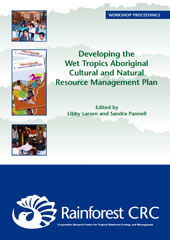 |
||||
 |
Back to Research Report Series |
|||
| Report No. 45 Developing the Wet Tropics Aboriginal Cultural and Natural Resource Management Plan Workshop Proceedings Libby Larsen and Sandra Pannell ISBN 0 86443 761 7 |
||||
|
Extract
from Part One The Aboriginal Plan took over three years to develop, commencing with the first Traditional Owner regional workshop held in March 2002 to discuss Indigenous involvement in NHT 2. Indigenous groups were largely excluded from the planning process in the first phase of the NHT program (1997-2001), and consequently only a handful of Aboriginal communities Australia-wide received funding support for NRM projects. Determined to rectify this state of Indigenous marginalisation in what is arguably a multi-billion dollar, nation-wide experiment in environmental management and social change, Traditional Owners, government and non-government organisations in the Wet Tropics region attended numerous workshops, meetings and presentations to develop an Aboriginal Plan. It has not been an easy task to develop this plan, and ensure acknowledgement of Indigenous perspectives and values in the broader Wet Tropics NRM planning process. Although there has been support from a number of individuals working within government departments (both State and Commonwealth) and FNQ NRM Ltd, the reality is that the framework for NHT 2 and the guidelines for the development of NRM plans do not adequately embrace and support Indigenous aspirations for caring for country. Thus, one of the major challenges encountered in developing the Aboriginal Plan was to broaden the focus and objectives of NHT at a regional, State and Commonwealth level. The promotion of a more holistic and integrated view of NRM is crucial if Indigenous aspirations are to be recognised in regional planning processes. Critical to this reformulation of current NRM models is the adoption of a whole-of-government approach to the articulation of NHT and the delivery of sustainable NRM outcomes. In this respect, in the process of developing the Aboriginal Plan, strategic partnership arrangements were developed between Traditional Owners, the Board of FNQ NRM Ltd, the Regional Group Collective, Commonwealth and State Government NRM teams and the Joint Steering Committee. As the first plan
of its kind to specifically address the many challenges of maintaining
distinct and diverse cultures in a multi-tenured and rapidly changing
landscape, it is important that the process of developing the Aboriginal
Plan is documented to ensure that other NRM regions and Indigenous groups
can benefit from the lessons learned within the Wet Tropics NRM region.
This is not to say that what has occurred in the Wet Tropics should
be used as a 'one-size-fits all' model for Indigenous engagement in
other NRM regions. Rather, some of the issues and ways in which the
Wet Tropics Aboriginal Plan Project Team (WTAPPT) attempted to shape
the NHT framework and planning process to better reflect Indigenous
people's values and priorities for natural and cultural resource management
may be used as an inspiration and guide for other Indigenous groups
in Australia. In addition to documenting the process leading to the
launch of the Aboriginal Plan at Innisfail on 29 April 2005, this document
also contains the proceedings of Aboriginal Plan development workshops
convened between March 2002 and December 2004. The content of these
proceedings have been retained not just for the 'historical record',
but also to illustrate the complexity and multi-processual nature of
the Plan's development. While a recent review of the NHT program identified
the Aboriginal Plan as a "case study of exemplary consultation
with Indigenous communities", suggesting to the general public
a process of clear and mutual understanding, the reality of the Plan's
evolution is quite different. As evident in the proceedings in part
two of this report, issues of cross-cultural interpretation, translation,
and comprehension were encountered on a daily basis. It is incorrect
to see these issues simply as one of the effects of imposing western
ideas about planning and management upon Aboriginal peoples and landscapes.
The NHT process brings together a number of different cultural systems,
including Indigenous, Anglo-Australian, scientific and bureaucratic
orders of meaning and value. In this culturally diverse context, misunderstanding
and mis-recognition on the part of those involved were, at times, the
unintended outcomes. As demonstrated in the proceedings, the Aboriginal
Plan owes its 'success' to those people willing to recognise and reconcile
differences in ideas, identities and ideals in this social experiment
in multi-cultural, multi-sectoral planning. |
 |
|||
|
Download Full Report
(9.85 Mb) |
||||
|
See below left to download sections. |
||||
| Back to top | ||||
 |
||||